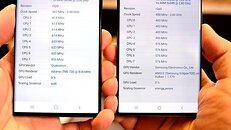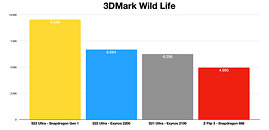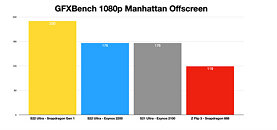- Joined
- Oct 9, 2007
- Messages
- 47,852 (7.39/day)
- Location
- Dublin, Ireland
| System Name | RBMK-1000 |
|---|---|
| Processor | AMD Ryzen 7 5700G |
| Motherboard | Gigabyte B550 AORUS Elite V2 |
| Cooling | DeepCool Gammax L240 V2 |
| Memory | 2x 16GB DDR4-3200 |
| Video Card(s) | Galax RTX 4070 Ti EX |
| Storage | Samsung 990 1TB |
| Display(s) | BenQ 1440p 60 Hz 27-inch |
| Case | Corsair Carbide 100R |
| Audio Device(s) | ASUS SupremeFX S1220A |
| Power Supply | Cooler Master MWE Gold 650W |
| Mouse | ASUS ROG Strix Impact |
| Keyboard | Gamdias Hermes E2 |
| Software | Windows 11 Pro |
The Exynos 2200 SoC powering the Samsung Galaxy S22 Ultra in some regions such as the EU, posts some less-than-stellar graphics performance numbers, for all the hype around its AMD-sourced RDNA2 graphics solution, according to an investigative report by Erdi Özüağ, aka "FX57." Samsung brands this RDNA2-based GPU as the Samsung Xclipse 920. Further, Özüağ's testing found that the Exynos 2200 is considerably slower than the Qualcomm Snapdragon 8 Gen 1 powering the S22 Ultra in certain other regions, including the US and India. He has access to both kinds of the S22 Ultra.
In the UL Benchmarks 3DMark Wildlife test, the Exynos 2200 posted a score of 6684 points, compared to 9548 points by the Snapdragon 8 Gen 1 (a difference of 42 percent). What's even more interesting, is that the Exynos 2200 is barely 7 percent faster than the previous-gen Exynos 2100 (Arm Mali GPU) powering the S21 Ultra, which scored 6256 points. The story repeats with the GFXBench "Manhattan" off-screen render benchmark. Here, the Snapdragon 8 Gen 1 is 30 percent faster than the Exynos 2200, which performs on-par with the Exynos 2100. Find a plethora of other results in the complete review comparing the two flavors of the S22 Ultra.




Özüağ predicts that Samsung could be working on a major software update that could improve or normalize performance between the two phone types. and that the Exynos 2200 is in need of significant software-level optimization. Özüağ also offers valuable insights into a possible cause the RDNA2-based Xclipse 920 is underwhelming. The iGPU could be starved for engine clocks, or we think possibly even memory bandwidth. Engine clocks play a decisive role in the performance of RDNA2-based discrete GPUs. AMD also spent significant engineering capital on lubricating the memory sub-system with the on-die Infinity Cache memory that operates at bandwidths typically 3-4 times that of the GDDR6 memory. The extremely tight power budget and Samsung 4 nm node could be impacting the iGPU's ability to sustain high engine clocks. We'll keep track on this story, as it marks AMD's second rodeo with smartphone graphics since the ATI Imageon days (over 14 years ago).
View at TechPowerUp Main Site
In the UL Benchmarks 3DMark Wildlife test, the Exynos 2200 posted a score of 6684 points, compared to 9548 points by the Snapdragon 8 Gen 1 (a difference of 42 percent). What's even more interesting, is that the Exynos 2200 is barely 7 percent faster than the previous-gen Exynos 2100 (Arm Mali GPU) powering the S21 Ultra, which scored 6256 points. The story repeats with the GFXBench "Manhattan" off-screen render benchmark. Here, the Snapdragon 8 Gen 1 is 30 percent faster than the Exynos 2200, which performs on-par with the Exynos 2100. Find a plethora of other results in the complete review comparing the two flavors of the S22 Ultra.




Özüağ predicts that Samsung could be working on a major software update that could improve or normalize performance between the two phone types. and that the Exynos 2200 is in need of significant software-level optimization. Özüağ also offers valuable insights into a possible cause the RDNA2-based Xclipse 920 is underwhelming. The iGPU could be starved for engine clocks, or we think possibly even memory bandwidth. Engine clocks play a decisive role in the performance of RDNA2-based discrete GPUs. AMD also spent significant engineering capital on lubricating the memory sub-system with the on-die Infinity Cache memory that operates at bandwidths typically 3-4 times that of the GDDR6 memory. The extremely tight power budget and Samsung 4 nm node could be impacting the iGPU's ability to sustain high engine clocks. We'll keep track on this story, as it marks AMD's second rodeo with smartphone graphics since the ATI Imageon days (over 14 years ago).
View at TechPowerUp Main Site





 Oh Samsung.
Oh Samsung.

